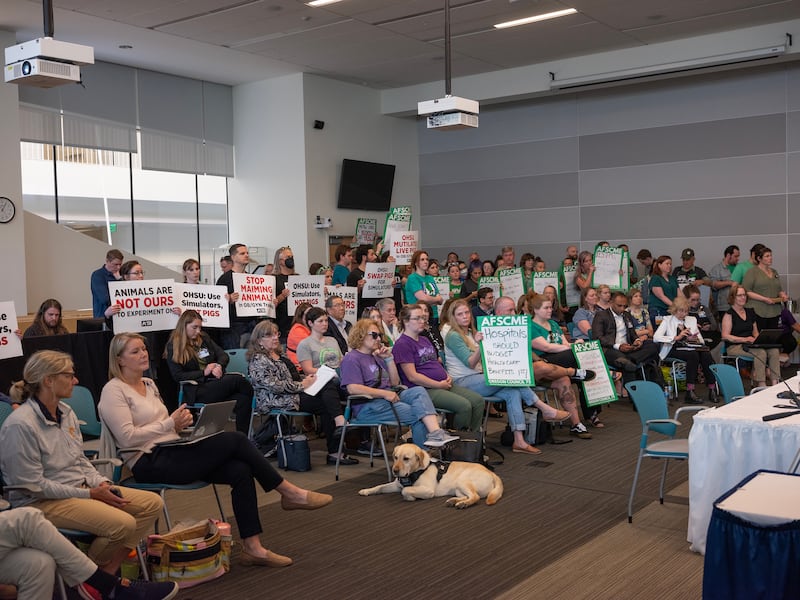At at meeting packed with disgruntled union members, the board of directors for Oregon Health & Science University voted unanimously Friday to cut more than 500 jobs, or about 2.4% of its workforce, to balance a budget strained by rising costs for salaries and supplies.
“I recognize how difficult and distressing this is, not only for those whose jobs will be lost, but also the impact that loss will have on their colleagues and others,” OHSU president Danny Jacobs said at the beginning of the meeting. “It’s not something that anyone wants to do, but it is a last resort.”
Employees knew the job cuts were likely to come. Jacobs described them in an email to staff on June 6, and the finance committee of the board reviewed them at a public meeting June 21.
OHSU is attempting to balance its budget as it pursues a purchase of crosstown rival Legacy Health, which, if approved by regulators, it would finance by issuing $1 billion in 30-year bonds. Though it would strengthen OHSU, the purchase is no panacea, Jacobs said.
“It will require sacrifice, and we can expect some tough years,” he said.
An estimated 75 members of the American Federation of State, County and Municipal Employees Local 328 and the Oregon Nurses Association filled the room to protest the job cuts. They held up signs reading “C-Suite Jobs Are Not Patient-Facing Positions” and “Hospitals Should Budget Healthcare.”

Many jeers and comments from the crowd referenced a $700,000 boost to the retirement account held by Jacobs and to the severance package given to former chief people officer Qiana Williams, who left earlier this month after saying that “a culture of complaint is pervasive at OHSU,” according to a recording of her comments obtained by WW. Before that, Williams hired much of her senior staff from Ohio, irking workers who felt she overlooked talent in Oregon.
Williams left with a one-time payment of $75,000 and the right to collect her $550,000 annual salary and health benefits until June 2025, unless she finds another job before then.
“I’d take Qiana’s severance package,” one sign said.
The board took heat from union members and others for how they’ve communicated plans to cut jobs under the “strategic alignment” plan. Amy Miller Juve, faculty senate president and professor of anesthesiology and perioperative medicine, addressed the board in her official capacity.
“While we recognize that OHSU is facing significant budget challenges, the process to improve our financial position while preserving high quality work is flawed,” Miller Juve said. “Decisions have been top down, lacked appropriate planning, and quite frankly, feel inhumane. The work underway is titled ‘Strategic Alignment.’ However, we struggle to understand the strategy or to what we are aligning, other than to cut expenses.”
Jennie Olson, president of AFSCME Local 328, said the union rallied members to come to the meeting en masse with signs because OHSU board chair Wayne Monfries declined their request to address the board in a more formal way.
“The response that we got for trying to advocate for people who are going to lose their jobs is despicable,” Olson said. “We asked for a seat at the table. They said there was no public comment at the meeting. This isn’t public comment. This is comment from your employees at OHSU.”
Tempers flared after Monfries asked if members of the finance committee had considered salary cuts for high earners to close the budget gap. Chief financial officer Lawrence Furnstahl called such cuts “a short-term strategy” that don’t result in “permanent savings to our budget.” The comments drew jeers.
Monfries rejoined by recommending to union members that “your messages are better served sending a note to the board so we can read them,” drawing more scorn.
After the board voted, union members filed out, grumbling.
“This was our last shot at asking for more money,” AFSCME Local 328 secretary Cassie Barton said. “They could still find it. They have a slush fund of $30 million to $40 million. They can make choices.”
Dr. Jeff Jensen, vice chair of research, obstetrics and gynecology in the OHSU School of Medicine and an outspoken critic of Jacobs, said the job cuts approved today are likely to do little good.
“I remain pessimistic about the future of OHSU,” Jensen said. “The concerns of faculty and staff received lip service. While I admit that OHSU has real financial problems, this board seems content to maximize the pain on the OHSU staff and make no apologies for a bloated and ineffective administration.”
